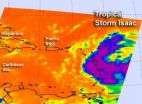(Press-News.org) CHAPEL HILL, N.C. – A collaborative research effort by scientists at the University of North Carolina School of Medicine, Duke University, and University College of London in the UK, sheds new light on alcohol-related birth defects.
The project, led by Kathleen K. Sulik, PhD, a professor in the Department of Cell and Developmental Biology and the Bowles Center for Alcohol Studies at UNC, could help enhance how doctors diagnose birth defects caused by alcohol exposure in the womb. The findings also illustrate how the precise timing of that exposure could determine the specific kinds of defects.
"We now know that maternal alcohol use is the leading known and preventable cause of birth defects and mental disability in the United States," Sulik said. "Alcohol's effects can cause a range of cognitive, developmental and behavioral problems that typically become evident during childhood, and last a lifetime."
Fetal alcohol syndrome (FAS) is at the severe end of fetal alcohol spectrum disorders (FASD). First described in 1972, FAS is recognized by a specific pattern of facial features: small eyelid openings, a smooth ridge on the upper lip (absence of a central groove, or philtrum), and a thin upper lip border.
In its full-blown state, FAS affects roughly 1 in 750 live births in the U.S. And while clinicians typically look for those classical facial features in making a diagnosis, within the broader classification of FASD "adverse outcomes vary considerably and most individuals don't exhibit the facial characteristics that currently define FAS," said the study's lead author Robert J. Lipinski, PhD, a postdoctoral scientist in Sulik's lab. "This study could expand the base of diagnostic criteria used by clinicians who suspect problems caused by maternal alcohol use."
In their animal-based studies, the Sulik lab team has collaborated with co-author G. Allan Johnson, PhD and his group at Duke University's Center for In Vivo Microscopy. Johnson, professor of radiology and physics, has developed new imaging tools with spatial resolution up to a million times higher than clinical magnetic resonance imaging (MRI). These include small bore tools suitable for imaging fetal mice that are only 15 mm long.
To quantify facial shape from MRI data, the study team turned to co-author Peter Hammond, a professor of computational biology at UCL's Institute of Child Health, in London. Hammond invented powerful new techniques for 3D shape analysis that have already proven successful in objectively defining facial shape changes in humans.
In the study, described in the August 22, 2012 issue of the online journal PLOS ONE, Lipinski and Sulik treated one group of mice with alcohol on their seventh day of pregnancy, a time corresponding to the third week of pregnancy in humans. A second group of mice was treated just 36 hours later, approximating the fourth week of human pregnancy. The amount of alcohol given was large, "high doses that most women wouldn't achieve unless they were alcoholic and had a tolerance for alcohol," Sulik said.
Near the end of pregnancy, the fetuses were then imaged at Duke University. These 3D data sets showed individual brain regions, as well as accurate and detailed facial surfaces, from which Hammond and research assistant and co-author Michael Suttie performed shape analyses.
The team found that the earlier alcohol exposure time elicited the classic FAS facial features, including characteristic abnormalities of the upper lip and eyes. What they observed in fetuses exposed just 36 hours later, however, was a surprise. These mice exhibited unique and in some cases opposing facial patterns, such as shortened upper lip, a present philtrum, and the brain, instead of appearing too narrow in the front, appeared wide.
"Overall, the results of our studies show that alcohol can cause more than one pattern of birth defects, and that the type and extent of brain abnormalities—which are the most devastating manifestation of prenatal alcohol exposure—in some cases may be predicted by specific facial features," Sulik said. "And, importantly, alcohol can cause tremendously devastating and permanent damage at a time in development when most women don't recognize that they're pregnant."
INFORMATION:
Co-authors include Shonagh O'Leary-Moore, Jacob J. Ament, Stephen J. Pecevich, Scott E. Parnell, Elizabeth A. Godin, Joshua L. Everson, Deborah B. Dehart, and Hunter T. Holloway of the UNC Bowles Center for Alcohol Studies; Francois Budin, Ipek Oguz, Martin A. Styner of the UNC department of psychiatry; and Yi Jiang of the Duke University Center for In Vivo Microscopy.
The project was supported by the National Institute of Alcoholism and Alcohol Abuse, the National Institute of Biomedical Imaging and Bioengineering and was conducted in conjunction with the Collaborative Initiative on Fetal Alcohol Spectrum Disorders (CIFASD).
Citation:
Lipinski RJ, Hammond P, O'Leary-Moore SK, Ament JJ, Pecevich SJ, et al. (2012) Ethanol-Induced Face-Brain Dysmorphology Patterns Are Correlative and Exposure-Stage Dependent. PLoS ONE 7(8): e43067. doi:10.1371/journal.pone.0043067
Research reported in this publication was supported by the National Institute Of Alcohol Abuse and Alcoholism of the National Institutes of Health under Award Numbers AA011605 and AA017124. The content is solely the responsibility of the authors and does not necessarily represent the official views of the National Institutes of Health.
Imaging study sheds new light on alcohol-related birth defects
2012-08-23
ELSE PRESS RELEASES FROM THIS DATE:
Moms linked to teen oral health, says CWRU dental study
2012-08-23
A mother's emotional health and education level during her child's earliest years influence oral health at age 14, according to a new study from Case Western Reserve University's School of Dental Medicine.
Researchers started with the oral health of the teens and worked backwards to age 3 to find out what factors in their past influenced their oral health outcomes.
While mothers were interviewed, lead investigator Suchitra Nelson, professor in the dental school, believes it can apply to whoever is the child's primary caregiver.
Nelson's team examined the teeth of 224 ...
Super-strong, high-tech material found to be toxic to aquatic animals
2012-08-23
Carbon nanotubes (CNTs) are some of the strongest materials on Earth and are used to strengthen composite materials, such as those used in high-performance tennis rackets. CNTs have potential uses in everything from medicine to electronics to construction. However, CNTs are not without risks. A joint study by the University of Missouri and United States Geological Survey found that they can be toxic to aquatic animals. The researchers urge that care be taken to prevent the release of CNTs into the environment as the materials enter mass production.
"The great promise ...
Nematodes with pest-fighting potential identified
2012-08-23
This press release is available in Spanish.
Formosan subterranean termites could be in for a real headache. U.S. Department of Agriculture (USDA) scientists have identified species of roundworms, or "nematodes," that invade the termite brains and offer a potential bio-based approach to controlling them. Other nematodes that were identified invaded tarantula brains.
The Formosan termite, a nonnative species from Asia, feeds on cellulose from the heartwood of trees, the wood support beams of buildings, and other sources. It causes an estimated $1 billion annually in ...
Cramming for a test? Don't do it, say UCLA researchers
2012-08-23
Every high school kid has done it: putting off studying for that exam until the last minute, then pulling a caffeine-fueled all-nighter in an attempt to cram as much information into their heads as they can.
Now, new research at UCLA says don't bother.
The problem is the trade-off between study and sleep. Studying, of course, is a key contributor to academic achievement, but what students may fail to appreciate is that adequate sleep is also important for academics, researchers say.
In the study, UCLA professor of psychiatry Andrew J. Fuligni, UCLA graduate ...
NASA sees Tropical Storm Isaac and Tropical Depression 10 racing in Atlantic
2012-08-23
VIDEO:
This animation of satellite observations from August 19-22, 2012, shows the development and movement of Tropical Storm Isaac toward the Lesser Antilles. This visualization was created by the NASA GOES...
Click here for more information.
There are now two active tropical cyclones in the Atlantic and NASA is generating satellite imagery to monitor their march westward. Tropical Storm Issac is already bringing rainfall to the Lesser Antilles today, Aug. 22, Tropical ...
University of Colorado analysis of election factors points to Romney win
2012-08-23
A University of Colorado analysis of state-by-state factors leading to the Electoral College selection of every U.S. president since 1980 forecasts that the 2012 winner will be Mitt Romney.
The key is the economy, say political science professors Kenneth Bickers of CU-Boulder and Michael Berry of CU Denver. Their prediction model stresses economic data from the 50 states and the District of Columbia, including both state and national unemployment figures as well as changes in real per capita income, among other factors.
"Based on our forecasting model, it becomes clear ...
Double trouble continues in the Philippine Sea: Tembin and Bolaven
2012-08-23
Typhoon Tembin and Typhoon Bolaven continue to churn in the Philippine Sea, and infrared satellite data from NASA showed the power within both storms.
The Atmospheric Infrared Sounder (AIRS) instrument that flies onboard NASA's Aqua satellite captured imagery of both storms on Aug. 21 in two different overpasses. Aqua flies over the same locations during early morning and early afternoon (local time) as it orbits the Earth. Aqua passed over the Philippine Sea on Aug. 21 at 04:41 UTC (12:41 a.m. EDT) and 16:47 UTC (12:47 p.m. EDT). The two satellite passes were combined ...
Scientists from UCLA, Israel's Technion uncover brain's code for pronouncing vowels
2012-08-23
Scientists at UCLA and the Technion, Israel's Institute of Technology, have unraveled how our brain cells encode the pronunciation of individual vowels in speech.
Published in the Aug. 21 edition of the journal Nature Communications, the discovery could lead to new technology that verbalizes the unspoken words of people paralyzed by injury or disease.
"We know that brain cells fire in a predictable way before we move our bodies," said Dr. Itzhak Fried, a professor of neurosurgery at the David Geffen School of Medicine at UCLA. "We hypothesized that neurons would ...
Video shows the traffic inside a brain cell
2012-08-23
Using bioluminescent proteins from a jellyfish, a team of scientists has lit up the inside of a neuron, capturing spectacular video footage that shows the movement of proteins throughout the cell.
The video offers a rare peek at how proteins, the brain's building blocks, are directed through neurons to renew its structure. It can be viewed online here: http://www.youtube.com/watch?v=baI9q2--q7s&feature=youtu.be
"Your brain is being disassembled and reassembled every day," said Don Arnold, associate professor of molecular and computational biology at the USC Dornsife ...
ORNL researchers probe invisible vacancies in fuel cell materials
2012-08-23
Knowing the position of missing oxygen atoms could be the key to cheaper solid oxide fuel cells with longer lifetimes. New microscopy research from the Department of Energy's Oak Ridge National Laboratory is enabling scientists to map these vacancies at an atomic scale.
Although fuel cells hold promise as an efficient energy conversion technology, they have yet to reach mainstream markets because of their high price tag and limited lifespans. Overcoming these barriers requires a fundamental understanding of fuel cells, which produce electricity through a chemical reaction ...


